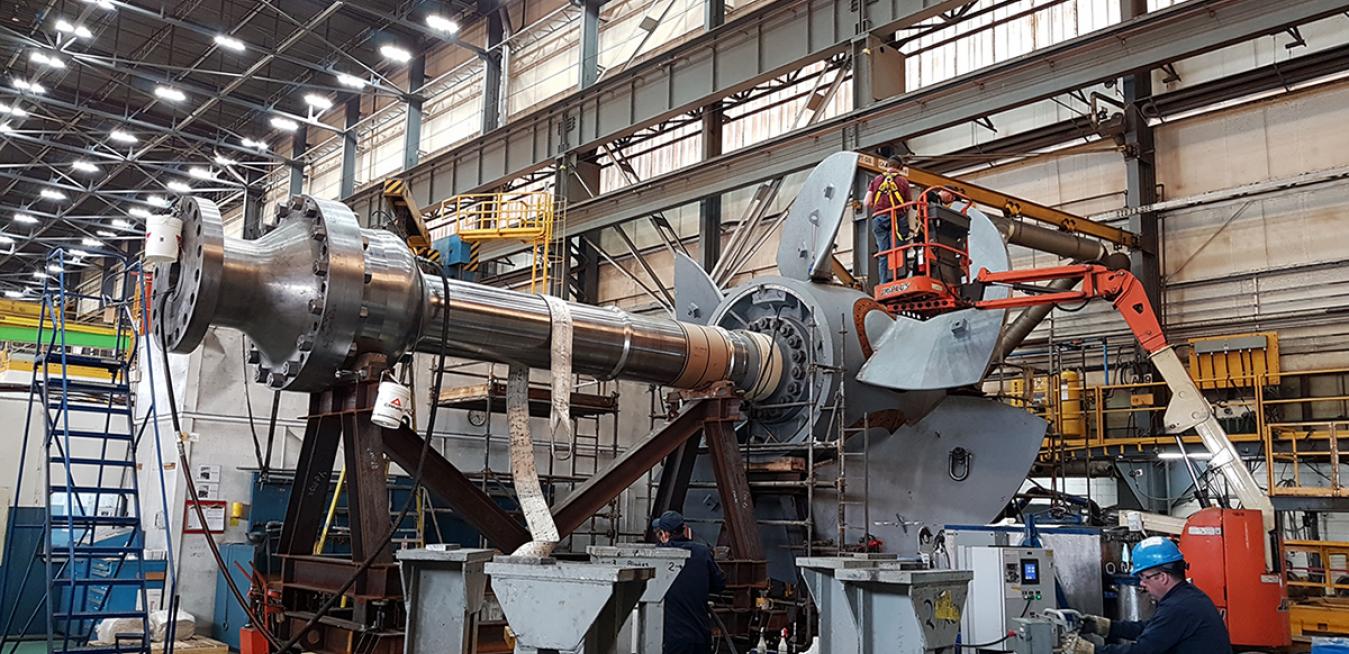LONG DISTANCE LEARNING
If you’re a customer buying a massive turbine for a hydroelectric dam, at some point you’ll probably travel to the factory where the machine is being built. That’s where you can see it get put through its paces, verifying that it works as promised and doesn’t fail under pressure. Called a factory acceptance test (FAT), that step is a normal part of the industrial process. But how do you complete it in abnormal times, when society is locked down and travel is discouraged? That was the challenge facing the U.S. Army Corps of Engineers this past spring, when it wanted to get a look at a turbine runner being built at a GE Hydro Digital Technology factory near Montreal — but had to do it from thousands of miles away. Luckily, a solution was at hand.
Far away, so close: The solution was in the engineers’ hands, or their pockets — it was an iPhone. The team in Montreal realized that if they hooked the device up to a tripod and a gimbal, it could yield a stable image detailed enough to show the test in action, provided they could also ensure wireless connectivity throughout their cathedral-like plant. The team conducted three dry runs to make sure the technology would provide sufficient audio and visual detail and, on March 24, the virtual FAT went off without a hitch. The hydro team has conducted two more remote tests, and is looking at using the capability for troubleshooting products being used around North America.
Learn more here about the newfound potential of virtual factory acceptance testing.
TRICKS OF THE TRADE
When he was a kid growing up in Toronto, Peter Tu liked to run around the neighborhood with his dog or oversee the reptile pit he built in his backyard. He particularly liked to teach tricks to his animal friends. Now 53 years old, Tu is still in the business of teaching new tricks — only now, his trainees aren’t dogs but computers. Tu is the chief scientist for artificial intelligence at GE Research and lately, he’s been looking at new ways to get artificial intelligence to learn, including by the kind of basic reasoning that dogs — and kids — excel at. “As children we do a large number of inductions,” Tu explained. “A child with limited examples is very good at drawing out general rules.” Can AI become good at that too?
Sit, stay, compute: AI is great at processing massive amounts of data and spotting subtle patterns. It’s less prepared for situations where it faces a “poverty of stimulus,” as Tu describes it — simply not enough information to go on. That’s where it could take a cue from kids as they’re learning their way through the world. Tu has been experimenting with providing young AI systems with the equivalent of parents — experts to offer gentle corrections, including exceptions to seemingly general rules, like those that govern language. If AI-enabled machines can master nuances in communicating with humans, and eventually with one another, Tu thinks, it’ll be a step toward machines that comprehend all sorts of problems. It’s all about working together: “I’ve always been of the opinion that we need more companions to walk down this path with us,” Tu said.
Learn more about Tu’s highly intelligent work here.
BARRON'S TOP CEOS
“Larry Culp was hired to turn around an American icon, and the early evidence suggests he is succeeding.” That’s the first line in a new Barron’s feature listing the GE chairman and CEO among the magazine’s top 25 CEOs of 2020. When Culp was named to the position in October 2018, he set out an ambitious program to transform GE. Nobody could have predicted he’d end up leading GE through a global pandemic and significant market volatility. “It will be a multiyear journey,” Culp told Barron’s.
Ready, reset, go: Introducing the list of top CEOs, Barron’s editor Jack Hough writes, "There is no resetting some things to the way they were.” That’s evident in many corners of GE, where digital technologies were already becoming central to the way things work — and now may point the way out of the crisis. In Oregon, for instance, GE Healthcare software is helping hospitals share critical information about resources, and digital analytics might become the new normal for commercial airlines, too. Those technologies could be critical to the recovery.
Read Barron’s on Culp here.
COOLEST THINGS ON EARTH ?
1. Organoids Of Progress
Teams of scientists around the world have been using lab-grown organoids — mini organs — to study the effects of COVID-19 on the body.
2. A Fine Mist
The biopharmaceutical company Gilead Sciences got the go-ahead from the U.S. Food and Drug Administration to begin clinical trials of a version of remdesivir — the first antiviral drug to show promise against COVID-19 — that’s delivered by inhaler.
3. Supermaterial Conditions
German and American researchers devised a new way to produce nanoribbons of graphene, which has been hailed as a supermaterial.
Read more here about this week’s Coolest Things on Earth.
— QUOTE OF THE DAY —
“Pre-COVID, nobody would have accepted doing this virtually. I’m sure that we will still have, at some point, some on-site FATs. But I’m also sure that a big part of the FATs will be done virtually.”
— Pascal Renouvin, chief information officer of global supply chain for GE Renewable Energy
Quote: GE Reports. Images: GE Renewable Energy.





